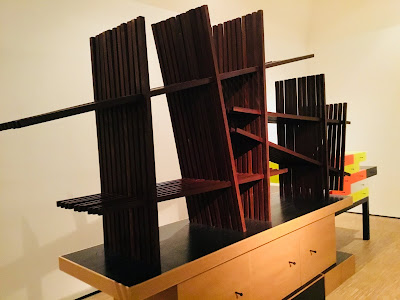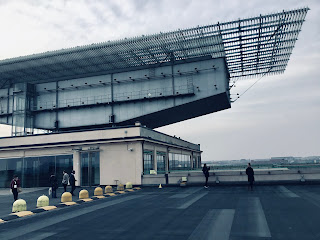FUTURISMO
I have been most intrigued on recent findings (my own findings) on the motivations for the emergence of the early 20th Century movement know as 'Il FUTURISMO', in particular the ambition to re-set history afresh. Would be unthinkable in a country so entrenched with history, but they did. They created a Manifesto and attracted a large audience. It was the first call towards what eventually became the "Made in Italy" with all the connotations and denotations known to many of us. There are a few observations here:
Socio-cultural standing: To make an aggessive impact on the cultural scene with clear actions that would disrupt the orthodox world. Both, inclusive and divisive, aiming to attract all artist that at the time where standing in a cultural vacuum or straight-jacket. A general audience rather than a privileged group. Somehow an ambition to what pop-art music achieved in the cultural revolution of the 60's....saying that, the Futurism was vocally aggressive, there was nothing subtle about it. The Futurist Manifesto managed to steered the pot.
Author: Fillipo Thomasso Marinetti is seen as the father of this movement. He was keen to go strong into an influential political position. He was aware of the dangers with art movements that go nowhere. In his book Mafarka il futurista (1909) where the hero of the story, set in Africa against a classical colonial background, is a superman who asserts that it is necessary to believe in the absolute and definitive power of the will, which has to be cultivated, intensified, by following a creul discipline".
Themes: movement, motion, dynamism; concrete, glass, steel; cars, planes, tanks; Moroccan-styled hats, garments with geometric patterns, abstraction; cities, landscapes and environments;buildings;objects rather than people as subjects (although, there were many portraits).
Medium: from fashion and textiles to painting, sculpture, architecture, civil projects (such as hydroelectric plants) and of course, into manufacturing, aerospace and automotive...and yes, the worshipping manufacturing, and as a consequence, "the machine"....and yes, the machine gun and armament in general.
Scale: It seems to me that the values of an emergent generation (as often happens) wanted to break away form the straight jacket of history. .....in which scale was not an issue. Image above is a bookshelf by Ettore Sottsass (1917 Innsbruk- 2007 Milano) exhibited at La Triennale di Milano in 20217. Technically not a futuristic artist by in my view this object sticks to all principles of dynamic movement set by Umberto Boccioni, Giacomo Balla (1871-1958) below:
Dynamism of a dog on a leash (G. Balla 1912).
Below the hydroelectric by Antonio Sant'Elia (1888 Como -1916 Monfalcone).
"We will fight with all our might the fanatical, senseless and snobbish religion of the past, a religion encouraged by the vicious existence of museums. We rebel against that spineless worshipping of old canvases, old statues and old bric-à-brac, against everything which is filthy and worm-ridden and corroded by time"
from the "Manifesto of Futurist Painters"
Even more...
"We Futurists, Balla and Depero, seek to realize this total fusion in order to reconstruct the universe, making it more joyful, in other words by a complete re-creation. We will give skeleton and flesh to the invisible, the impalpable, the imponderable and the imperceptible. We will find abstract equivalents for every form and element in the universe, and then we will combine them according to the caprice of our inspiration, creating plastic complexes which we sill set in motion."
From the "Futurist Reconstruction of the Universe" (Fortunato Depero, 11 of March, 1915)
In 1914 Antonio Sant'Elia, published the manifesto Futurist Architecture, in which he argued that it was a
"question of tending the healthy growth of the Futurist house, constructing it with all the resources of technology and science, satisfying magisterially all the demands of our habits and our spirit, tampling down all that is grotesque and antithetical (tradition, style, aesthetics, proportion), determining new forms, new lines, a new harmony of profiles and volumes, an architecture whose reason for exisstence can be found solely in the unique conditions of modern life (...)"
this was clearly a rejection of decor and heavy architecture. A new aesthetic emerged, a new way to go about history and tradition... or not. A fresh start. "(a) taste for the light, the practical, the ephemeral and swirt" and the inventive use of materials like (all new a the time) reinforced concrete, steel, glass... all adding to a new language of the emerging modernity.
"All things move, all things run, all things are rapidly changing. Objects multiply themselves, their forms change like rapid vibrations, in their mad career. The running horse (in a painting or sculpture) does not have four legs, but twenty, and their movements are triangular."
Technical Manifesto of Futurist Painting, signed on 11th of April, 2010
Lastly, Fillipo Tommaso Marinetti (a total nut-head!) while in Paris, wrote and article that appeared in Le Figaro "Manifesto of Futurism".
"We want to exalt movements of aggression, feverish sleeplessness, the double march, the perilous leap, the slap and the blow with the fist. We declare that the splendour of the world has been enriched by a new beauty: the beauty of speed. A racing automobile...is more beautiful than the Victory of Samothrace".











